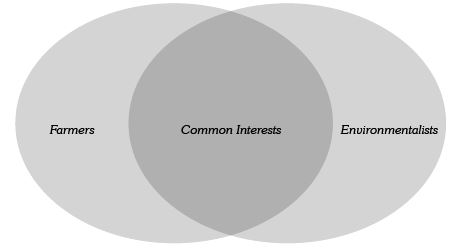The land is the livelihood of farmers. Most people, farmers included, try to avoid practices that harm their way of life. When raising crops and livestock, farmers actively manage soil, water, plants, and animals. Farming is one of the closest working relationships that people have with the environment, and sometimes farming practices lead to environmental problems. Often, it takes years for the environmental impacts of human activity to become evident, and it can be complicated to identify and change environmentally damaging actions. Farmers work both to produce food and to care for the land that is their livelihood. There are many different strategies for accomplishing these goals.
Considering the history of environmental issues can put modern-day controversies into context. People began polluting long ago. Early settlers in the United States dumped their trash into rivers and streams without considering the harm it might do. Before gasoline-powered tractors began releasing exhaust fumes, work horses created pollution problems of their own. The average farm horse produces 35 pounds of solid waste and 2 gallons of liquid waste each day. Although horse manure can be an excellent fertilizer when spread across a field, large amounts in small areas can create high concentrations of nitrogen and bacteria that can contaminate the water supply.
Thousands of years ago, people began to farm because they found they could produce more food in a more reliable manner by growing crops than by hunting and gathering. Over the years, people discovered that some farming practices harmed the land. Cutting down trees, clearing vegetation, and allowing animals to overgraze left the topsoil unprotected and vulnerable to erosion by wind and water. Planting the same crop on the same field year after year used up all the soil’s nutrients, and the fields lost their ability to produce good crops.
Early farmers learned from their mistakes and developed better farming methods. They learned to farm on the contour and build terraces—ridges of soil built across the slope to slow water runoff. They learned to rotate their crops (crop rotation), moving them from one field to another to let the soil rest. They learned how to spread animal manure on their fields to restore organic matter and nutrients.
When European settlers came to the New World, they were dazzled by what seemed like endless resources—acres and acres of rich soil. Many farmers abandoned the methods their ancestors used to protect the land. When one field began to produce poor crops, the farmer would simply abandon it and move farther into the wilderness.
As more people moved in, more land was needed for farms. In the early twentieth century, farmers began plowing up the native grasses of the Southern Plains to plant wheat. They had no way of knowing that their hard work would be the first step leading to what would come to be known as the Dust Bowl. A severe drought dried up the exposed soil. With no grass roots to hold the sandy soil in place, it simply blew away with the strong summer winds.
Recognizing a problem is the first step toward solving it. Farmers didn’t know that plowing up large, flat tracts of land would cause the soil to blow away in the event of a drought. Once they saw what had happened, they did what farmers have been doing for thousands of years. They began thinking of different methods they could use that would protect the soil.
One method involved using chemicals on weeds instead of turning the soil with a plow. For many years, this method seemed like an excellent way to keep the soil in place while producing the food people needed. Then, scientists discovered that some chemicals were getting into the water supply and making birds, fish, animals, and people sick. Other chemicals have begun to lose their effectiveness as weeds develop resistance to them. Today, farmers and agricultural researchers are working on ways to solve food production problems while taking into consideration the growing world population, the state of food prices and economics, and the condition of environmental resources such as soil and water.
